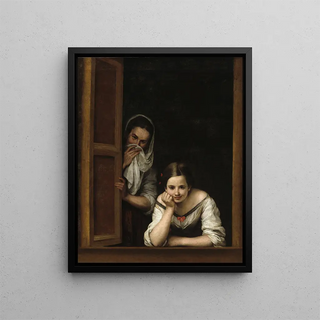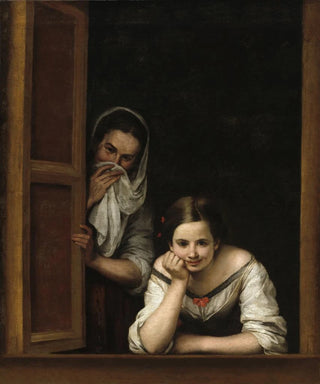Art print | Two women at a window - Bartolomé Esteban Murillo


View from behind

Frame (optional)
In the captivating universe of baroque art, the art print "Deux femmes à une fenêtre" by Bartolomé Esteban Murillo stands out for its delicacy and intimacy. Painted in the 17th century, this canvas embodies not only a frozen moment in time but also an exploration of human emotions through the prism of light and color. The scene takes place in a domestic setting, where two women, both mysterious and approachable, seem to converse with the outside world. The window, a symbol of passage between inside and outside, invites the viewer to ponder their story and relationship. This work, of great sensitivity, immerses us in an atmosphere filled with softness and melancholy, awakening in us a sense of empathy and curiosity.
Style and uniqueness of the work
Murillo, master of chiaroscuro, uses light as a powerful narrative tool. In "Deux femmes à une fenêtre," the natural light entering through the opening creates striking contrasts, highlighting the faces of the protagonists while darkening the background. This technique enhances the intimacy of the scene, emphasizing the connection between the women and the viewer. The delicate expressions on their faces, full of life and subtlety, reveal a psychological depth that transcends a simple portrait. The drapery of their clothing, carefully painted, adds a tactile dimension to the work, while the warm, earthy colors evoke an atmosphere of comfort and warmth. The balanced composition, centered on the female figures, guides the eye and creates a visual harmony that delights the observer.
The artist and his influence
Bartolomé Esteban Murillo, an emblematic figure of the Spanish Golden Age, knew how to mark his era with his unique style and his ability to capture the essence of humanity. Trained in Seville, he was influenced by great masters such as Velázquez and Caravaggio, but quickly developed his own approach, characterized by an increased sensitivity towards female subjects and children. Murillo was also a pioneer in representing everyday life, moving away from

Matte finish

View from behind

Frame (optional)
In the captivating universe of baroque art, the art print "Deux femmes à une fenêtre" by Bartolomé Esteban Murillo stands out for its delicacy and intimacy. Painted in the 17th century, this canvas embodies not only a frozen moment in time but also an exploration of human emotions through the prism of light and color. The scene takes place in a domestic setting, where two women, both mysterious and approachable, seem to converse with the outside world. The window, a symbol of passage between inside and outside, invites the viewer to ponder their story and relationship. This work, of great sensitivity, immerses us in an atmosphere filled with softness and melancholy, awakening in us a sense of empathy and curiosity.
Style and uniqueness of the work
Murillo, master of chiaroscuro, uses light as a powerful narrative tool. In "Deux femmes à une fenêtre," the natural light entering through the opening creates striking contrasts, highlighting the faces of the protagonists while darkening the background. This technique enhances the intimacy of the scene, emphasizing the connection between the women and the viewer. The delicate expressions on their faces, full of life and subtlety, reveal a psychological depth that transcends a simple portrait. The drapery of their clothing, carefully painted, adds a tactile dimension to the work, while the warm, earthy colors evoke an atmosphere of comfort and warmth. The balanced composition, centered on the female figures, guides the eye and creates a visual harmony that delights the observer.
The artist and his influence
Bartolomé Esteban Murillo, an emblematic figure of the Spanish Golden Age, knew how to mark his era with his unique style and his ability to capture the essence of humanity. Trained in Seville, he was influenced by great masters such as Velázquez and Caravaggio, but quickly developed his own approach, characterized by an increased sensitivity towards female subjects and children. Murillo was also a pioneer in representing everyday life, moving away from






